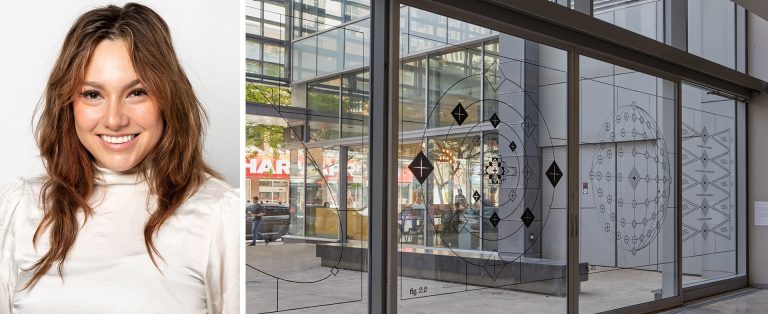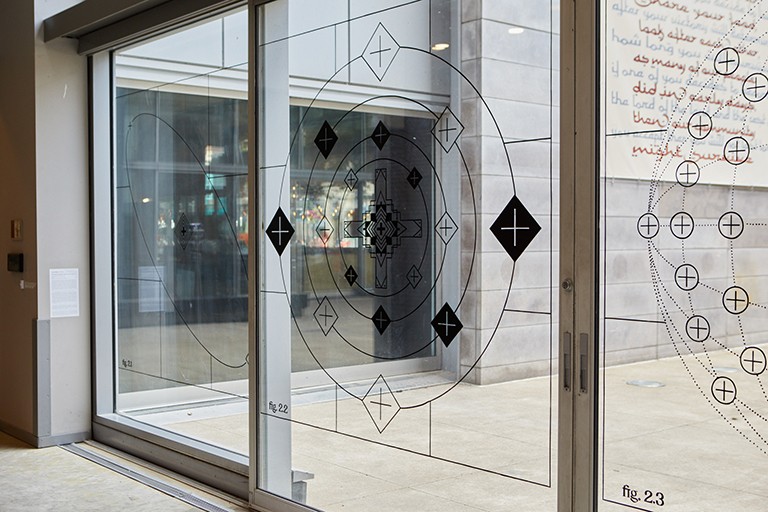Indigenous knowledges and AI come together in Suzanne Kite’s exhibition at Concordia’s FOFA Gallery

In Lakȟóta traditions, materials like metals and minerals each have unique essences and relationships to humans.
Oglála Lakȟóta artist and composer Suzanne Kite, PhD 2023, draws on these ideas for her installation, Hél čhaŋkú kiŋ ȟpáye (There lies the road): How to Make Art in a Good Way. Based on her Concordia PhD thesis, the exhibition is showing at the FOFA Gallery until November.
“The Imákȟaheye (Method) graphics installed at the FOFA Gallery are designed as visual representations of my theories for developing and maintaining future relationships to nonhumans,” Kite says.
“The graphics synthesized what I learned from my PhD interviews with the Lakȟóta community around the Pine Ridge Reservation about making and maintaining relationships with non-human beings in a good way, and ways to make new creations such as art or AI,” she adds, referring to the reserve in South Dakota, United States.
Guest musicians recorded a sound component of the installation to go along with the graphics. The musicians were invited to improvise while listening to various pieces of media, such as a drone Kite created with a traditional Íŋyaŋ song.
The work was hand painted on glass by 2Lettreurs, a Montreal signage company run by Concordia MFA grads Alexandre Saumier Demers and Malcolm McCormick. The painters worked onsite in an effort to meet sustainability initiatives and create less waste.

An intersection of traditional and futuristic views
Each illustration is the fruit of conversations held with Lakȟóta community members, offering different Indigenous perspectives on creation and artistry. Kite extrapolated the ideas explored in these discussions into future applications relating to hot-button topics such as artificial intelligence.
“There are symbols for stones and stars and transformations, representing how decisions move energy from one world to the next. I understand the creation of new things, including AI, as having the potential for ethics when using established frameworks for mutual reciprocity and respect of all beings,” she says.
Kite is a graduate of Bard College in Annandale-on-Hudson, New York, and originally hails from Southern California. She has collaborated with various Indigenous and Lakȟóta communities internationally, including artists such as Santee Luke Witt from South Dakota and Bobby Joe Smith III.
“One of the most important collaborations in this project was with Santee Luke Witt, a singer, composer and educator,” Kite explains.
“Witt shared his methods and thoughts around writing new songs extensively and worked with the Third Coast Percussion ensemble to share his compositions alongside a performance of scores based on their dreams. Witt’s insights influenced my approach to composing and creating those scores.”
The hand-painted graphics resulted from a collaboration with Smith, a Black and Lakȟóta graphic designer and artist based in Los Angeles.
“Smith created all the graphics for the original exhibition of this work, which was commissioned by the Vera List Center in 2021. I explained my theories to him and sent him initial drawings, and he developed those into graphics for each idea as well as exhibition materials, handouts, and vinyls,” Kite notes.
“Smith also made graphics for my family tree and maps of my interviews. I am very honoured to have gotten to collaborate with him.”
Exploring ethical boundaries in new technologies
Kite’s work can be said to explore the relationships between two seemingly distinct forms of knowledge in North American culture: Indigenous methodologies and emerging technologies like AI.
Though some may fear that the recent tidal wave of new technologies could overwhelm us, Kite embraces these innovations.
“In my artwork, I explore the boundaries of what is ethically possible with technology. I have a wide range of artworks that use tools like DeepFakes and natural language processing to critique the relationships between AI and colonialism,” she says.
“It is my belief that it is possible to create new things in an ethical way. It will be the innovation and exploration of new technologies that will allow us to find new pathways that do not require perpetual destruction.”
Visit Hél čhaŋkú kiŋ ȟpáye (There lies the road) by Suzanne Kite at Concordia’s FOFA Gallery until November.




